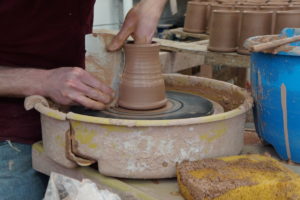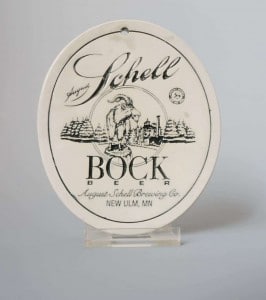How can you make a cup of coffee taste better? Drink it out of a handmade ceramic mug. Making coffee mugs by hand is a little more involved than methods of mass production, especially when the mugs are customized. But the extra effort involved adds a special touch to the mugs, making it well worth it.
Creating the Mug

Every stoneware coffee mug starts out the same, as a lump of unfinished clay. How much clay is needed depends on the size of the mug. A small 8-ounce mug will need less than a pound of clay while larger mugs tend to need anywhere from a pound to almost two pounds.
After the right amount of clay is measured out, it’s placed on a potter’s wheel to be shaped. While the wheel spins, the potter uses his or her hands to shape the mug. The exact shape depends on the style of mug. Diner mugs tend to have thick walls that bend in slightly towards the center. Potbelly mugs are slender at the opening, but have a bulbous base. Bistro mugs can be round or tall and slender, with clean, simple lines.
The handle for the mug is made separately, also by hand. It’s pulled and shaped and allowed to dry slightly before the potter scores the ends of it and scores the places on the mug where the handle will attach. Scoring involves making marks on the clay so that the two pieces will stay fused together when the mug is fired in the kiln, or oven.
The Logo Medallion
 A custom mug wouldn’t be complete without a custom logo. One method of creating custom logos is to use a scrimshaw process on ceramic.
A custom mug wouldn’t be complete without a custom logo. One method of creating custom logos is to use a scrimshaw process on ceramic.
Scrimshaw was first used by whalers and hunters, who would carve elaborate designs into the whale bones or ivory husks that were left over after a hunt. Today, most artists use more sustainable materials for scrimshaw, such as ceramic.
The technique is the same whether ceramic or bone is used. The artist uses a sharp, pointed object to etch the logo or design into the ceramic.
Glazing the Mugs
Along with the custom logo, the glaze, or paint, on a mug is what really allows it to be unique. The glazes Grey Fox uses are all made in house and can’t be found anywhere else.
When you order handmade mugs, you can choose pretty much any color of the rainbow for your mugs’ glaze. You can also choose colors that aren’t in the rainbow, such as brown, grey, white or black.
Handmade mugs aren’t limited to just one glaze color, either. You can choose two colors, one of the top and one for the bottom of the mug, to create a unique two-tone look. The method of glazing makes it look as though one color is seeping down into the other.
Firing the Mugs
A ceramic mug isn’t finished until it’s been fired in a kiln. Firing the mugs hardens both the clay and the glaze, so you end up with sturdy, durable product your customers can drink out of for many years to come.
Handmade mugs are usually fired twice. During the first firing, the mugs are unglazed. Heating them in a the oven allows the clay to dry out and harden, so that it is easier to handle when it is being glazed. The second firing allows the glazes to melt onto the clay and to harden.
No two handmade stoneware coffee mugs are exactly alike. If you’re looking for mugs to use at your cafe or restaurant or want a one-of-a-kind product to sell to customers, it’s worth considering custom-made mugs.

